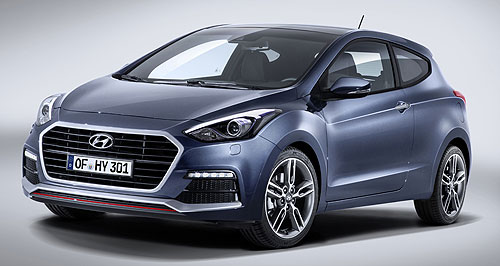Puff daddy: Hyundai has transplanted its turbo-charged engine into its i30 hatch as part of a mid-life facelift.
Gallery

Click to see larger images
HYUNDAI’S top-selling i30 small car is in for a boost – literally – with the addition of a turbo-charged direct-injected engine as part of a mid-life facelift for 2015, at least in some markets.
A new hexagonal grille, redesigned bumpers, seven-speed dual-clutch transmission and fuel-saving technologies are among the changes to the hatchback and wagon range due in Australia in the first quarter.
While the turbo engine is of interest to Hyundai Motor Company Australia (HMCA), it is yet to confirm if or when it might arrive in the local line-up that is getting its first major makeover since the current model arrived in 2012.
Called i30 Turbo in Europe, the blown sporty five-door hatch is powered by a detuned version of the 1.6-litre Gamma T-GDI four-cylinder petrol engine that drives Hyundai’s Veloster SR Turbo and sister company Kia’s Cerato Koup Turbo.
Instead of 150kW of power like the Veloster and Koup, the i30 Turbo gets 137kW at 5500rpm. However, torque output is the same at 265Nm from 1500rpm.
This is 10kW and 56Nm more than the current most powerful powertrain offered in Australia, the 129kW/209Nm normally aspirated 2.0-litre four-cylinder of the i30 SR.
Available only with a six-speed manual transmission and mounted on sports-tuned suspension and 18-inch alloy wheels, the new i30 Turbo is said to be capable of an 8.0-second 0-100km/h dash – 0.3 seconds slower than the existing 2.0-litre i30 SR.
While a new seven-speed dual-clutch transmission has been added to the i30 range, it will be confined to the less powerful normally aspirated 1.6-litre GDI petrol engine and 1.6-litre turbo diesel.
Hyundai says the new transmission improves fuel efficiency over the torque converter unit, which appears to continue on in other models as an alternative to the six-speed manual gearbox.
In Europe, the diesel will be offered in two states of tune – 81kW and 100kW – while three petrol engines will be available: new 74kW/134Nm 1.4-litre, 88kW/156Nm 1.6 litre, and the 137kW/265Nm 1.6-litre T-GDI.
All engines are Euro 6 compliant, with the best fuel efficiency offered by the diesel, at 3.6 litres per 100km on the European combined test cycle.
Petrol engine fuel consumption ranges from 5.6L/100km for the 1.4-litre unit, to 7.3L/100km for the T-GDI turbo.
Among new fuel-saving technologies in Europe are idle stop, low rolling-resistance tyres, an alternator management system (AMS) and a drag-reducing ‘active air flap’ in the front grille.
Externally, the most noticeable change to the i30 is the new hexagonal grille that aligns the hatch and wagon with newer Hyundai models.
New alloy wheels and three fresh colours – polar white, orange caramel and jet black – complete the changes to the basic range.
The i30 Turbo also gets Euro-style red detailing on the new-look front and rear bumpers, a revised LED light design and twin exhausts. Inside, sports from seats, sports instrument cluster and red trim detailing complete the package.
A sports body kit would seem ideal for the revised i30 SR in Australia, where HMCA chief operating officer John Elsworth is on record as saying the sports model needs more visual bling.
HMCA public relations general manager Bill Thomas told GoAuto the revised i30 would land in Australian showrooms in the first quarter of 2015, but it was too early to say which powertrains would be included in the Australian line-up, and whether the i30 Turbo would be part of the range.
“It is of interest to us, but there is nothing final on it,” he said. “We are looking at the equation of price and so on, but we can’t confirm anything.” The i30 is Hyundai’s best-selling model, racking up 28,677 sales so far in 2014, representing a year-to-date rise of 2.3 per cent.
In the top-selling small car segment, it trails only the Toyota Corolla (40,189) and Mazda3 (39,510).
But when the 8007 sales of i30’s sedan sister car, Elantra, are added, Hyundai’ s small car sales add up to 36,284.

Facebook Twitter Instagram